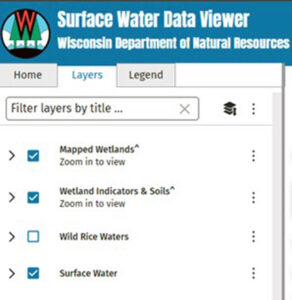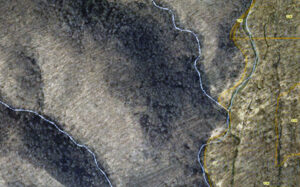By Wisconsin DNR

The Wisconsin Department of Natural Resources’ online Surface Water Data Viewer layers panel. / Graphic Credit: Wisconsin DNR
From recreation, to aesthetics, to ecosystem function and everything in between, there are many ways that water is an important aspect of owning and managing a property. It could be the showcase feature of a property such as lake frontage or a scenic river, or as subtle as a seasonal waterway or forested wetland.
Many landowners own woodlands because they want to enjoy the scenic beauty and protect nature and water. A first step toward achieving those goals is understanding what is present on the respective property. The Wisconsin Department of Natural Resources has a useful tool called the Surface Water Data Viewer (SWDV) to help landowners and land managers identify water resources.
The SWDV contains many datasets, but for initial identification of water resources the key map layers are surface water, mapped wetlands and wetland indicators and soils. Simply navigate in the map to the property and turn on the layers as needed to see what is present on the property. A user guide [PDF] is available for the SWDV.

A map view on the Wisconsin Department of Natural Resources’ online Surface Water Data Viewer shows intermittent streams (blue lines) and mapped wetlands (orange shading). / Graphic Credit: Wisconsin DNR
Knowing what water features are located on a property factors into several considerations to help protect the water resources:
- How do the water features impact forest roads and trails?
- Is frozen ground access or timber harvest seasonality a concern?
- What BMPs might be needed?
- Are permits possibly needed for stream crossing or wetland projects?
- Are water features adequately accounted for in the MFL stewardship plan or cutting notice?
The Wisconsin Forest Management Guidelines and Wisconsin’s Forestry Best Management Practices for Water Quality Field Manual are excellent resources to help landowners and land managers weigh these considerations, incorporate the water features into forest management planning and implement forest management that to achieve landowner goals for aesthetics, water protection and practicing sound forestry.
